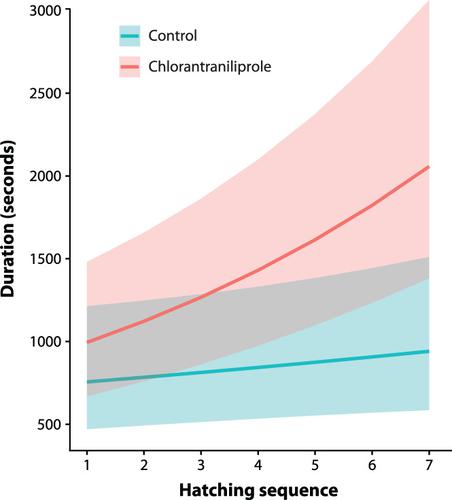当前位置:
X-MOL 学术
›
Ann. Appl. Biol.
›
论文详情
Our official English website, www.x-mol.net, welcomes your
feedback! (Note: you will need to create a separate account there.)
Toxic effect of chlorantraniliprole on new-born larvae of the potato tuber moth Tecia solanivora (Lepidoptera: Gelechiidae)
Annals of Applied Biology ( IF 2.2 ) Pub Date : 2021-02-26 , DOI: 10.1111/aab.12688
Tito Bacca 1 , Nhora J. Cabrera 2 , Yeisson Gutiérrez 3
Annals of Applied Biology ( IF 2.2 ) Pub Date : 2021-02-26 , DOI: 10.1111/aab.12688
Tito Bacca 1 , Nhora J. Cabrera 2 , Yeisson Gutiérrez 3
Affiliation

|
The potato tuber moth Tecia solanivora is an invasive species threatening potato crops and stored tubers. Previous studies have shown that South American populations of this species have evolved insecticide resistance to major classes of insecticides (i.e., pyrethroids, carbamates and organophosphates). Therefore, testing for other methods of pest control is of increasing importance. In this study, we evaluated the toxic effect of chlorantraniliprole against early immature stages of T. solanivora. We carried out a concentration–mortality bioassay using eggs. Subsequently, we subjected eggs to several insecticide application scenarios and evaluated hatching success, larvae activity and overall mortality of immature stages. Additionally, we analysed the hatching behaviour of larvae when the eggs were treated with chlorantraniliprole. After the concentration–mortality bioassay, we calculated an LC50 of 298.6 ppm, yet the mortality did not occur during the egg-phase, but rather the neonate larvae experienced the toxic effects of chlorantraniliprole. In the subsequent exposure-mode bioassay, the hatching success was overall high in all treatments, and larvae mortality reached 100% regardless of exposure mode. Consequently, larvae activity was severely reduced when in contact with the insecticide. Furthermore, when eggs are subjected to such LC50 dose, larvae manage to break through the chorion, but after releasing the legs, each hatching stages takes longer than the previous. Our results highlight the potential use of chlorantraniliprole for the control of T. solanivora in stored potato tubers. Additionally, chlorantraniliprole appears to be a promising alternative for the control of T. solanivora populations resistant to neurotoxic insecticides.
中文翻译:

氯虫苯甲酰胺对马铃薯块茎蛾 Tecia solanivora(鳞翅目:Gelechiidae)新生幼虫的毒害作用
马铃薯块茎蛾Tecia solanivora是一种威胁马铃薯作物和储存块茎的入侵物种。以前的研究表明,该物种的南美种群已经进化出对主要类别的杀虫剂(即拟除虫菊酯、氨基甲酸酯和有机磷酸盐)的杀虫剂抗性。因此,测试其他害虫控制方法变得越来越重要。在本研究中,我们评估了氯虫苯甲酰胺对T. solanivora早期未成熟阶段的毒性作用. 我们使用鸡蛋进行了浓度-死亡率生物测定。随后,我们将鸡蛋置于几种杀虫剂应用场景中,并评估了未成熟阶段的孵化成功率、幼虫活动和总体死亡率。此外,我们分析了用氯虫苯甲酰胺处理卵时幼虫的孵化行为。在浓度-死亡率生物测定后,我们计算了 LC 50298.6 ppm,但在卵期并未发生死亡,而是新生幼虫经历了氯虫苯甲酰胺的毒性作用。在随后的暴露模式生物测定中,所有处理的孵化成功率总体较高,无论暴露模式如何,幼虫死亡率均达到 100%。因此,当与杀虫剂接触时,幼虫的活性会严重降低。此外,当卵接受这样的 LC 50剂量时,幼虫设法突破绒毛膜,但在释放腿后,每个孵化阶段需要比前一个更长的时间。我们的结果强调了氯虫苯甲酰胺在控制茄虫的潜在用途在储存的马铃薯块茎中。此外,氯虫苯甲酰胺似乎是控制对神经毒性杀虫剂有抗药性的T. solanivora种群的有希望的替代品。
更新日期:2021-02-26
中文翻译:

氯虫苯甲酰胺对马铃薯块茎蛾 Tecia solanivora(鳞翅目:Gelechiidae)新生幼虫的毒害作用
马铃薯块茎蛾Tecia solanivora是一种威胁马铃薯作物和储存块茎的入侵物种。以前的研究表明,该物种的南美种群已经进化出对主要类别的杀虫剂(即拟除虫菊酯、氨基甲酸酯和有机磷酸盐)的杀虫剂抗性。因此,测试其他害虫控制方法变得越来越重要。在本研究中,我们评估了氯虫苯甲酰胺对T. solanivora早期未成熟阶段的毒性作用. 我们使用鸡蛋进行了浓度-死亡率生物测定。随后,我们将鸡蛋置于几种杀虫剂应用场景中,并评估了未成熟阶段的孵化成功率、幼虫活动和总体死亡率。此外,我们分析了用氯虫苯甲酰胺处理卵时幼虫的孵化行为。在浓度-死亡率生物测定后,我们计算了 LC 50298.6 ppm,但在卵期并未发生死亡,而是新生幼虫经历了氯虫苯甲酰胺的毒性作用。在随后的暴露模式生物测定中,所有处理的孵化成功率总体较高,无论暴露模式如何,幼虫死亡率均达到 100%。因此,当与杀虫剂接触时,幼虫的活性会严重降低。此外,当卵接受这样的 LC 50剂量时,幼虫设法突破绒毛膜,但在释放腿后,每个孵化阶段需要比前一个更长的时间。我们的结果强调了氯虫苯甲酰胺在控制茄虫的潜在用途在储存的马铃薯块茎中。此外,氯虫苯甲酰胺似乎是控制对神经毒性杀虫剂有抗药性的T. solanivora种群的有希望的替代品。































 京公网安备 11010802027423号
京公网安备 11010802027423号